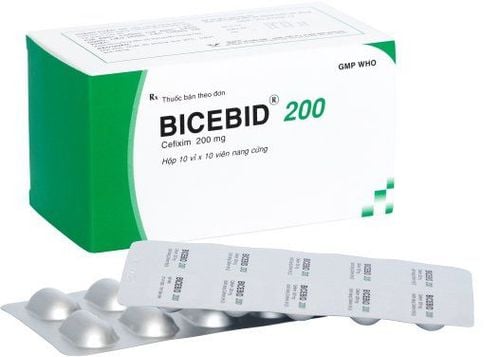This is an automatically translated article.
In the treatment of infectious diseases, antibiotics are indispensable drugs. However, the use of antibiotics should be prescribed for each disease and in the right dose. The most accurate way to calculate the antibiotic content is the way to calculate the antibiotic content according to the patient's weight. This calculation holds true for both children and adults.
1. How to calculate antibiotic content for upper respiratory tract infections
The upper respiratory tract includes the entire structure of the respiratory tract from the larynx upwards, including the ears, sinuses, V.A and tonsils. The causative agent of upper respiratory tract infection is usually gram-positive bacteria such as streptococcus, staphylococcus, and pneumococcus.
The first antibiotic should be selected as beta-lactam antibiotics, mainly against gram-positive bacteria. The order of selection and calculation of antibiotic content by weight in the treatment of upper respiratory tract infections is as follows:
AMOXICILLIN is used at a dose of 50-100mg/kg/day, divided into 2-3 times. AMOXICILLIN - CLAVULANIC (brand name commonly used is Augmentin, claminate, klamentin, shinacin...). For children, there are three common types: 250mg amox/31.25mg clavulanic, 500mg amox/62.5mg clavulanic and 500mg/125mg clavulanic. The dose is calculated according to the amoxicillin dose with the formula 50-90 mg/kg/day. CEFUROXIME is a 2nd generation cephalosporin antibiotic used at a dose of 20-30mg/kg/day in 2 divided doses. CEFACLOR 125 mg with the calculation of the content is 1 pack per 5kg of weight. 3rd generation cephalosporin antibiotics: Cepodoxime is used at a dose of 10mg/kg/day divided into 2 times. Cefdinir drug at a dose of 15 mg / kg / day divided into 2 times. Cefixime at a dose of 6-10 mg/kg/day divided into 2 doses. Note that when using these antibiotics, they must be used for at least 5 days if there is a response, do not stop taking them before 5 days. AZITHROMYCIN is used at a dose of 10 mg/kg/day, taken once on an empty stomach, for 3-5 days if there is a response. CLARYTHROMYCIN is used at a dose of 15mg/kg/day, divided into 2 times, used for 5-7 days. ERYTHROMYCIN is used at a dose of 40-50 mg/kg/day divided into 2 times, an average of 1 pack of 250mg is used for every 5kg of body weight. In cases of acute otitis media, acute sinusitis ... should use AMOXICLLIN - CLAVULANIC because it has the ability to enter the ear tissue and sinuses better than other antibiotics. In addition, a high dose should be used with a calculation that is 75-90 mg/kg/day as amoxicillin.
2. How to calculate antibiotic content for lower respiratory tract infections
Antibiotics commonly used in the treatment of lower respiratory tract infections include:
AMOXICILIN or AMOXICILLIN - CLAVULANIC with amoxicillin dose of 90 mg/kg/day in 2 divided doses. CEFDINIR is used at a dose of 14 mg/kg/day in 2 divided doses. CEFPODOXIME is used at a dose of 10 mg/kg/day in 2 divided doses. For children over 5 years old with pneumonia, it is recommended to add AZITHROMYCIN with a dose of 10 mg/kg/day, up to a maximum of 500 mg/day. For children under 5 years of age, after 2 days of treatment, if there is no or slow response to the drug, it should be combined with azithromycin at the above dose. After 2 days (after 4 courses of antibiotics) it is necessary to assess drug response. If there is a good response, continue treatment for at least 7-10 days. If the response is slow or non-responsive, the doctor should consider changing the antibiotic or adding another antibiotic. Particularly with AZITHROMYCIN, if the response is good, it should only be used for 5 days, because the half-life of the drug is long.
3. How to calculate antibiotic content for gastrointestinal infections
Antibiotics commonly used in the treatment of gastrointestinal infections include:
CIPROFLOXACIN using a dose of 30mg/kg/day divided into 2 times. TRIMETHOPRIME - SULFAMETHOXAZON (common brand names are biseptol, cotrim, bactrim..) 480mg tablet form, used at a dose of 1 tablet / 10kg (or 48 mg / kg / day) divided into 2 times. CEFIXIME is used at a dose of 10 mg/kg/day in 2 divided doses. AZITHROMYCIN is used at a dose of 20mg/kg/day in a single dose. Or use dose of 20mg/kg/day for the first day and dose of 10mg/kg/day for day 2 and 3. METRONIDAZOLE for cases of enteritis caused by amoebic dysentery use a dose of 30mg/kg/day in 2 divided doses.
4. How to calculate antibiotic content for skin and soft tissue infections
The most common cause of skin and soft tissue infections is skin staphylococcus, staphylococcus aureus, and streptococcus. The doctor can choose one of the following antibiotics to prescribe for the patient:
AMOXICILLIN, or AMOX-CLABULANIC using a dose of 75-90mg/kg/day (calculated according to Amoxicillin). CEFDINIR is used at a dose of 14 mg/kg/day. Erythromycin is used at a dose of 50 mg/kg/day. FUCIDIN can be applied topically.
5. How to calculate antibiotic content for urinary tract infections
Treatment of urinary tract infections usually use the following antibiotics:
BISEPTOL 480mg (also known as COTRIME) Use a dose of 1 tablet for every 10kg of weight, divided into 2 times a day. CIPROFLOXACIN is used at a dose of 30mg/kg/day. AMOX-CLAvulanic is used at a dose of 50-90 mg/kg/day. CEFUROXIME is used at a dose of 30 mg/kg/day. The way to calculate the amount of antibiotics above is also the way to calculate the dose of antibiotics for children, to ensure that children receive the right amount of antibiotics for their body weight. Accordingly, in order to use the drug safely, patients need to strictly follow the instructions of the doctor or pharmacist.
Follow Vinmec International General Hospital website to get more health, nutrition and beauty information to protect the health of yourself and your loved ones in your family.
Please dial HOTLINE for more information or register for an appointment HERE. Download MyVinmec app to make appointments faster and to manage your bookings easily.













